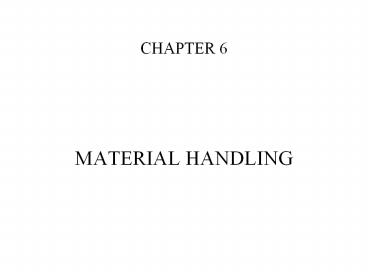MATERIAL HANDLING PowerPoint PPT Presentation
1 / 18
Title: MATERIAL HANDLING
1
CHAPTER 6
- MATERIAL HANDLING
2
Material Handling
- Material handling is the function of moving the
right material to the right place in the right
time, in the right amount, in sequence, and in
the right condition to minimize production cost. - The cost of MH estimates 20-25 of total
manufacturing labor cost in the United States
The Material Handling Industry of America (MHIA)
3
Goals of Material Handling
- The primary goal is to reduce unit costs of
production - Maintain or improve product quality, reduce
damage of materials - Promote safety and improve working conditions
- Promote productivity
- material should flow in a straight line
- use gravity! It is free power
- move more material at one time
- mechanize material handling
- automate material handling
4
Goals of Material Handling
- Promote increased use of facilities
- Reduce tare weight (dead weight)
- Control inventory
5
Overview of Material Handling Equipment
- Material handling equipment includes
- Transport Equipment industrial trucks, Automated
Guided vehicles (AGVs), monorails, conveyors,
cranes and hoists. - Storage Systems bulk storage, rack systems,
shelving and bins, drawer storage, automated
storage systems. - Unitizing Equipment palletizers
- Identification and Tracking systems
6
Considerations in Material Handling System Design
- 1. Material Characteristics
7
Considerations cont.
- 2. Flow rate
Quantity of material moved
Conveyors
Conveyors AGV train
High
Manual handling Hand trucks
Powered trucks Unit load AGV
Low
Long
Short
Move Distance
8
Considerations cont.
- 3. Plant Layout
9
20 Principles of Material Handling
- 1. The Planning Principle
- Large-scale material handling projects usually
require a team approach. - Material handling planning considers every move,
every storage need, and any delay in order to
minimize production costs. - The plan should reflect the strategic objectives
of the organization as well as the more immediate
needs.
10
- 2. The systems principle MH and storage
activities should be fully integrated to form a
coordinated, operational system that spans
receiving, inspection, storage, production,
assembly, , shipping, and the handling of
returns. - Information flow and physical material flow
should be integrated and treated as concurrent
activities. - Methods should be provided for easily identifying
materials and products, for determining their
location and status within facilities and within
the supply chain.
11
- 3. Simplification principle
- simplify handling by reducing, eliminating, or
combining unnecessary movement and/or equipment. - Four questions to ask to simplify any job
- Can this job be eliminated?
- If we cant eliminate, can we combine movements
to reduce cost? (unit load concept) - If we cant eliminate or combine, can we
rearrange the operations to reduce the travel
distance? - If we cant do any of the above, can we simplify?
12
- 4. Gravity principle
- Utilize gravity to move material whenever
practical. - 5. Space utilization principle
- The better we use our building cube, the less
space we need to buy or rent. - Racks, mezzanines, and overhead conveyors are a
few examples that promote this goal.
13
- 6. Unit load principle
- Unit loads should be appropriately sized and
configured at each stage of the supply chain. - The most common unit load is the pallet
- cardboard pallets
- plastic pallets
- wooden pallets
- steel skids
- pp 164 - 169
14
- 8. Automation principle
- MH operations should be mechanized and/or
automated where feasible to improve operational
efficiency, increase responsiveness, improve
consistency and predictability, decrease
operating costs. - ASRS is a perfect example.
15
- 10. Equipment selection principle
- Why? What? Where? When? How? Who?
- If we answer these questions about each move, the
solution will become evident. - Look at pp 160-161.
- 11. The standardization principle
- standardize handling methods as well as types and
sizes of handling equipment - too many sizes and brands of equipment results in
higher operational cost. - A fewer sizes of carton will simplify the storage.
16
- 13.
17
- 12. The dead weight principle
- Try to reduce the ratio of equipment weight to
product weight. Dont buy equipment that is
bigger than necessary. - Reduce tare weight and save money.
- 13. The maintenance principle
- Plan for preventive maintenance and scheduled
repairs of all handling equipment. - Pallets and storage facilities need repair too.
- 14. The capacity principle
- use handling equipment to help achieve desired
production capacity - i.e. material handling equipment can help to
maximize production equipment utilization.
18
Example
- A punch press can cycle every 0.03 minute, but
our time standard for manually loading and
unloading this press is only 300 pieces per hour. - Press capacity 60 min / 0.03 2000 pieces/hr
- Utilization 300 / 2000 15
- Should we buy a new press?
- If we can purchase a coil-feeding material
handling system, we could approach 100 press
utilization.

